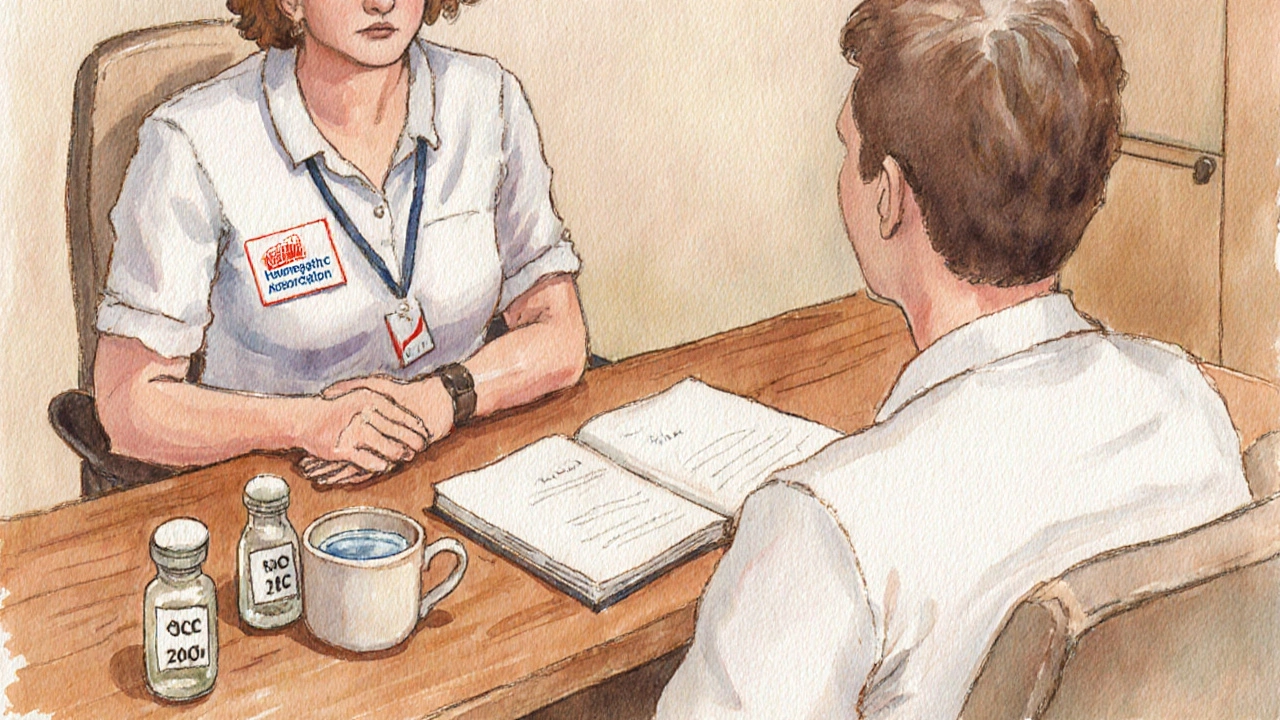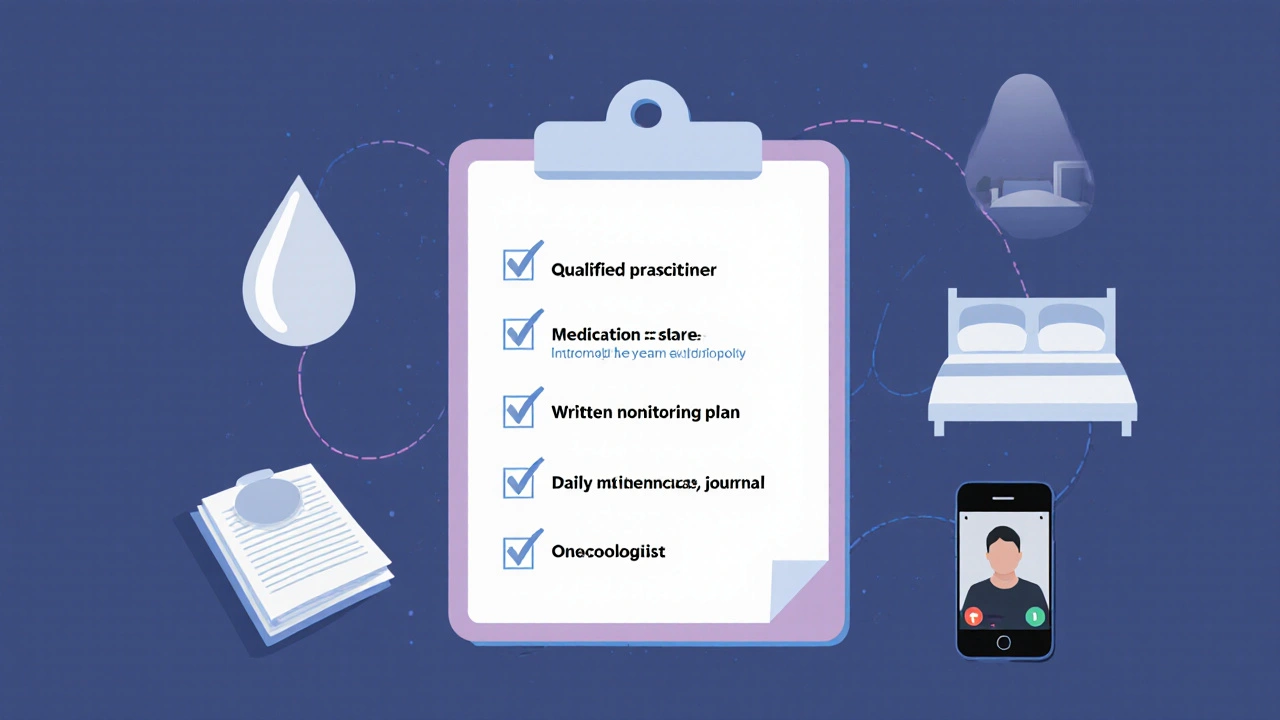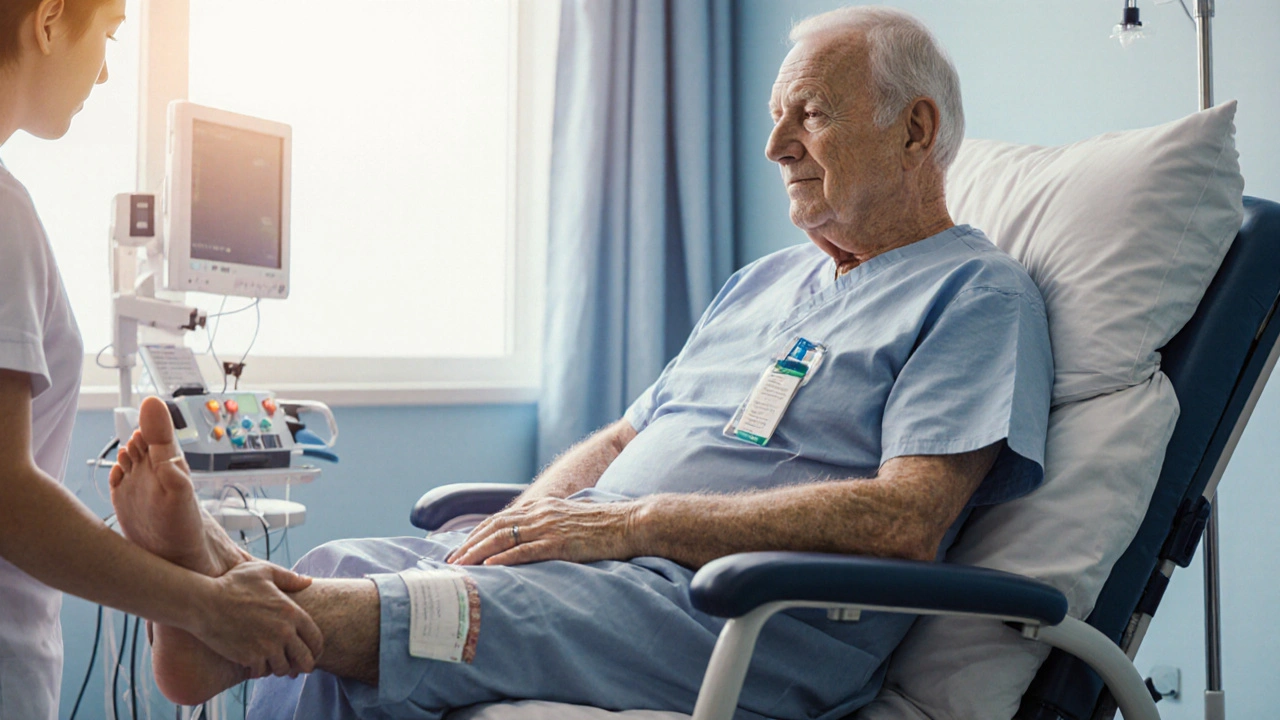Myeloma Side Effects Assessment Tool
Assess Your Side Effects
Identify your current treatment side effects to get personalized homeopathic suggestions. Remember: homeopathy should never replace conventional treatment.
Recommended Homeopathic Remedy
Safety Checklist
Before trying homeopathy:
- Consult with your oncology team
- Share your full medication list
- Find a qualified practitioner
- Do not substitute prescribed medications
- Monitor symptoms daily
Key Takeaways
- Multiple myeloma treatment often brings fatigue, neuropathy, nausea, and bone pain.
- Homeopathy uses highly diluted substances and aims to stimulate the body’s own healing response.
- High‑quality clinical evidence supporting homeopathy for myeloma side‑effects is limited.
- When used, homeopathy should never replace conventional therapy and must be coordinated with the oncology team.
- A simple checklist can help patients integrate homeopathic remedies safely.
Facing a myeloma diagnosis means dealing with aggressive treatments and a laundry list of side effects. Many patients wonder if myeloma homeopathy can soften the blow. Below we unpack what multiple myeloma is, which side effects are most common, how homeopathy works, what the research says, and practical steps for anyone considering a homeopathic approach.
What Is Multiple Myeloma?
Multiple Myeloma is a cancer of plasma cells that live in bone marrow, leading to abnormal antibody production, bone lesions, anemia, and kidney dysfunction. The disease accounts for roughly 10% of blood‑cancer diagnoses in the United Kingdom and typically affects people over 60. While novel agents such as proteasome inhibitors and immunomodulatory drugs have extended median survival to 5‑7 years, treatment is still intensive and often brings challenging side effects.
Common Treatment‑Related Side Effects
Standard myeloma regimens combine chemotherapy, steroids, and sometimes an autologous stem‑cell transplant. The most frequently reported adverse effects include:
- Fatigue and reduced stamina
- Peripheral neuropathy (tingling or numbness in hands/feet)
- Nausea and loss of appetite
- Bone pain and increased fracture risk
- Oral mucositis and dry mouth
- Immune suppression leading to infections
These symptoms can degrade quality of life and, in some cases, force dose reductions or treatment delays. That’s why many turn to complementary approaches, hoping to mitigate discomfort without jeopardising the primary therapy.

Homeopathy: Principles and Practice
Homeopathy is a system of alternative medicine founded in the 18th‑century by Samuel Hahnemann, based on the ideas of “like cures like” and potentisation through serial dilution. Practitioners select a remedy that, in a healthy person, would produce symptoms similar to those the patient is experiencing. The remedy is then diluted-often beyond Avogadro’s number-believing that the process transfers a “memory” of the substance to the water.
In the UK, homeopathic products are regulated by the Medicines and Healthcare products Regulatory Agency (MHRA) but are not subject to the same stringent efficacy testing as conventional drugs. The British Homeopathic Association (BHA) promotes professional standards and provides a directory of qualified practitioners.
What Does the Evidence Say?
The National Cancer Institute (NCI) notes that high‑quality randomized controlled trials (RCTs) for homeopathy in cancer care are scarce. A 2022 systematic review of 12 RCTs exploring homeopathic adjuncts for chemotherapy‑induced nausea, neuropathy, or fatigue found mixed results, with most studies suffering from small sample sizes and methodological flaws.
One small UK pilot (n=30) reported modest improvement in fatigue scores when patients received individualized homeopathic formulas alongside standard care, but the authors cautioned that placebo effects could not be ruled out. Conversely, a 2023 German trial found no statistically significant benefit of a specific homeopathic remedy for chemotherapy‑related neuropathy.
Regulatory bodies such as the Food and Drug Administration (FDA) in the United States have issued warnings that homeopathic products should not be marketed as “cures” for serious diseases without solid evidence.
Bottom line: the current scientific literature does not provide convincing proof that homeopathy reliably reduces myeloma treatment side effects. However, anecdotal reports and low‑risk profiles keep it on many patients’ radar.
Safety, Interactions, and Professional Oversight
Because homeopathic remedies are highly diluted, direct pharmacological interactions with chemotherapy agents are rare. Nevertheless, safety concerns arise when patients:
- Choose over‑the‑counter preparations without consulting a qualified practitioner.
- Replace prescribed anti‑emetics, analgesics, or growth‑factor support with homeopathic alternatives.
- Ignore signs of infection or worsening neuropathy, assuming the remedy will “fix” the problem.
For these reasons, any homeopathic plan should be discussed with the oncology team. The Complementary Medicine (CM) guidelines from the British Association for Cancer Research recommend documenting all non‑prescribed therapies in the patient’s medical record.

Practical Guidance: Using Homeopathy Safely
If you decide to explore homeopathy, follow this simple checklist:
- Find a credentialed practitioner. Look for membership in the BHA or a similar professional body.
- Share your full medication list. Include chemotherapy protocols, steroids, anti‑pain drugs, and any supplements.
- Ask for a written remedy plan. The plan should specify potencies, dosage frequency, and duration.
- Monitor side effects daily. Keep a journal noting fatigue levels, neuropathy intensity, nausea episodes, and any new symptoms.
- Report any worsening to your oncologist immediately. Adjustments to chemo doses take precedence over complementary measures.
Most homeopathic remedies are taken sublingually (under the tongue) and can be stored at room temperature. Adherence to the prescribed potency (e.g., 30C, 200C) is crucial; higher dilutions are not automatically “stronger.”
How Homeopathy Stacks Up Against Other Complementary Options
Patients often compare homeopathy with approaches like acupuncture, yoga, or mindfulness. Below is a quick side‑by‑side look at three popular modalities for managing myeloma‑related side effects.
| Therapy | Primary Benefits | Evidence Strength | Typical Cost (UK) | Safety Concerns |
|---|---|---|---|---|
| Homeopathy | Potential reduction in fatigue, nausea; individualized remedy | Low - small pilots, limited RCTs | £30‑£80 per consultation + remedies | Minimal pharmacologic interaction; risk of substitution |
| Acupuncture | Neuropathy relief, pain control, nausea reduction | Moderate - several RCTs show benefit for chemotherapy‑induced nausea | £50‑£120 per series (6‑10 sessions) | Bleeding risk if platelet count low; infection control |
| Yoga / Mindfulness | Improves fatigue, mood, sleep quality | Moderate - meta‑analyses support QoL improvements | £10‑£30 per class (or free videos) | Low; avoid extreme poses with bone lesions |
Choosing the right adjunct depends on personal preference, accessibility, and how each therapy aligns with your overall treatment plan.
Frequently Asked Questions
Can homeopathy cure multiple myeloma?
No. Homeopathy has not been proven to cure or halt the progression of multiple myeloma. It may be used only as a complementary approach to help with specific side effects, and always under the guidance of an oncologist.
Is it safe to take homeopathic remedies while receiving chemotherapy?
Because the remedies are highly diluted, direct drug interactions are unlikely. However, safety hinges on not substituting prescribed anti‑emetics, painkillers, or growth‑factor support with homeopathic products. Always inform your treatment team.
How do I find a qualified homeopathic practitioner?
Look for membership in the British Homeopathic Association or the Society of Homeopaths. Check that the practitioner holds a recognized qualification (e.g., BHMS, M.PH.) and has experience working with oncology patients.
What homeopathic remedies are most commonly used for chemotherapy side effects?
Practitioners often select remedies based on the patient’s symptom profile. Common choices include Nux vomica for nausea, Arsenicum album for fatigue, and Causticum for neuropathic tingling. Individualization is key-what works for one person may not suit another.
Should I stop homeopathy if my side effects worsen?
Yes. Any worsening of symptoms-especially fever, severe neuropathy, or infection-requires immediate medical evaluation. Homeopathy is a supportive tool, not a substitute for emergency care.
In summary, homeopathy can be part of a broader supportive strategy for myeloma patients, but the evidence for its effectiveness is limited. Prioritize open communication with your oncology team, choose qualified practitioners, and keep safety at the forefront of any complementary plan.


Deepak Bhatia
I'm really sorry you have to go through this. Managing myeloma treatment is tough, but staying on top of the side‑effects can make a big difference. Keep a daily log of fatigue, nausea, and any tingling sensations, then share it with your oncologist. Small lifestyle tweaks – like short naps, staying hydrated, and gentle stretching – often help lighten the load. Remember you’re not alone in this journey.
Samantha Gavrin
Don’t be fooled by the mainstream hype; most “homeopathic” remedies are just sugar pills with no real backing. The pharma industry and big‑tech regulators keep us in the dark, pushing false hope while they line their pockets. If you truly want an edge, look into the hidden studies that were quietly suppressed, not the glossy brochures you see online.
NIck Brown
Look, the truth is simple: you either stick to evidence‑based protocols or you drift into pseudoscience. Homeopathy may sound gentle, but without solid data it can waste precious time that could be spent on proven supportive care like acupuncture or physiotherapy. Focus on what’s documented, and don’t let wishful thinking derail your treatment plan.
Andy McCullough
From a mechanistic standpoint, the pharmacodynamics of highly diluted homeopathic preparations remain uncharacterized, which means we lack a reproducible dose–response curve. Nevertheless, some clinicians report subjective improvements in chemotherapy‑induced nausea when integrating individualized potencies alongside anti‑emetic regimens, suggesting a possible placebo‑mediated effect. It’s crucial to document baseline symptom scores using validated tools such as the FACT‑Fatigue subscale before introducing any adjunct, then reassess after a defined interval. This approach ensures you can quantitatively evaluate any incremental benefit while maintaining rigorous safety monitoring.
Zackery Brinkley
That’s a solid plan, Andy. Keeping track of numbers lets you and your team see what’s actually helping, and you can adjust the remedy or dosage accordingly. Also, staying hydrated and getting a bit of light movement each day can boost your overall energy without interfering with chemo.
Luke Dillon
Exactly, Zackery. I’ve seen patients feel more in control when they have a simple chart on the fridge reminding them to log fatigue, appetite, and any tingling. It turns a chaotic week into manageable steps.
Elle Batchelor Peapell
When you’re caught in the whirlpool of cancer treatments, it’s easy to feel like you’re just a passenger on a ship you didn’t choose. Yet, the little choices-like whether to sip a homeopathic tincture or not-can become acts of agency, tiny rebellions against the illness. They may not alter the tide, but they shape how you experience the ride.
Jeremy Wessel
Agency matters; small actions give purpose.
Laura Barney
Think of it like adding a splash of pigment to a gray canvas-you’re not changing the canvas itself, but you’re creating a visual cue that says, “I’m still here, I’m still vibrant.” That’s what complementary practices can do: they brighten the mental backdrop while the medical team handles the heavy lifting.
Jessica H.
It is incumbent upon both patients and clinicians to scrutinize the extant literature concerning adjunctive therapies for multiple myeloma. A systematic review published in 2022 evaluated twelve randomized controlled trials that examined homeopathic interventions for chemotherapy‑induced side effects. The authors concluded that methodological deficiencies, including small sample sizes and inadequate blinding, precluded definitive conclusions. Moreover, the reported effect sizes were modest at best and failed to reach clinical significance in most endpoints. In contrast, studies investigating acupuncture and mindfulness have demonstrated reproducible reductions in nausea and fatigue, respectively, across multiple cohorts. The regulatory stance of agencies such as the FDA reinforces the necessity for rigorous evidence before endorsing any therapeutic claim. Consequently, it would be prudent to regard homeopathy as a complementary, rather than primary, modality in the management of treatment‑related morbidity. Patients should be encouraged to maintain an exhaustive medication list, documenting any over‑the‑counter or alternative products alongside prescribed agents. This practice facilitates pharmacovigilance and allows the oncology team to assess potential interactions, however unlikely they may be with highly diluted substances. Additionally, the implementation of a structured symptom‑tracking instrument, for example the MD Anderson Symptom Inventory, can provide objective data to inform clinical decisions. While anecdotal reports of individual benefit are not to be dismissed outright, they must be contextualized within the broader evidence hierarchy. Healthcare providers ought to engage in shared decision‑making, presenting both the known risks and the uncertain benefits of homeopathic remedies. Such transparent communication preserves patient autonomy while safeguarding against inadvertent neglect of evidence‑based care. Finally, ongoing research initiatives should aim to elucidate any plausible mechanisms of action, thereby bridging the gap between traditional practice and contemporary biomedical science. Until such data are forthcoming, the default recommendation remains adherence to proven supportive interventions accompanied by vigilant multidisciplinary oversight.
Tom Saa
The quest for certainty often blinds us to the simple truth: we know very little.
John Magnus
From a translational oncology perspective, integrating adjuncts lacking phase‑III validation risks confounding endpoint integrity, potentially diluting the statistical power of survival analyses. Therefore, any incorporation of homeopathic protocols must be accompanied by stringent protocol‑driven monitoring, predefined interim analyses, and clear stopping rules to preserve trial rigor.